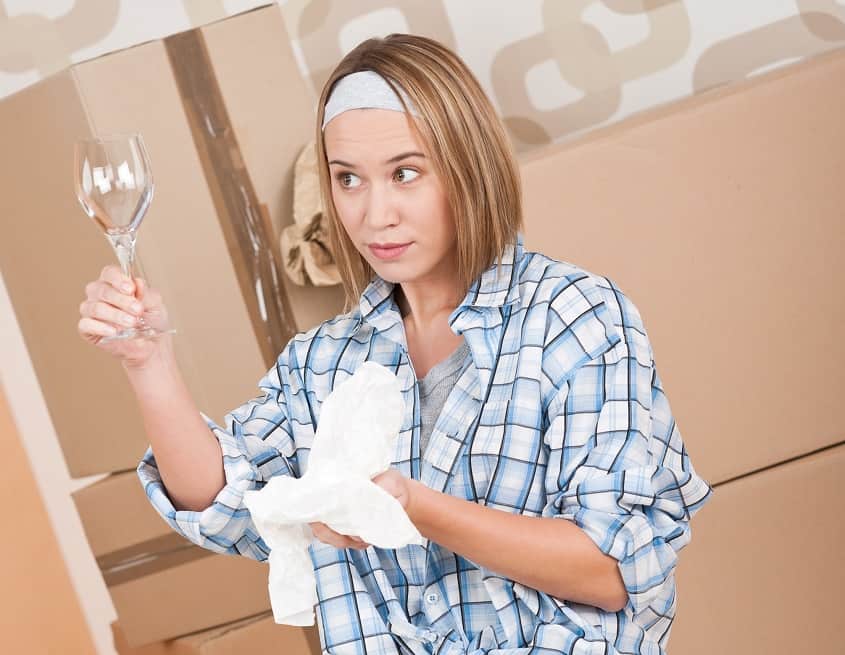Whether you have a set of your grandmother’s china or an everyday set of dishes from Ikea, you don’t want them to break while moving. Here are some great tips that will help ensure that everything’s in one piece when you open that box in your new home.
Whether you have a set of your grandmother’s china or an everyday set of dishes from Ikea, you don’t want them to break while moving. How to pack glasses for moving isn’t as easy as you might think, especially since there are so many different shapes and sizes. Here are some helpful tips that will help ensure that everything’s in one piece when you open that box in your new home.
Remember, take your time and be gentle, especially with delicate items. If you’d rather leave some packing to a professional moving company, contact us for a free quote! As certified movers in Pembroke, we offer a wide range of packing services to suit your needs.

Free Ultimate Moving Checklist
Say goodbye to moving stress with our 2023 residential moving checklist for Canada—it’s the ultimate time-saver!
Download NowBefore You Start – Donate Dishes You No Longer Want
The kitchen is the room most people use daily. It’s often the last room to be packed up and the first to be unpacked. The key to tackling this section of your house is to stay organized and have a solid plan in place.
Before you begin packing for a move, you’ll want to take some time and sort through what you have. Chances are, there are some items in your kitchen (or any room in your house) that you no longer want or need. Getting rid of wine glasses or old plates that you never use will save you the trouble of moving them and will free up some valuable space in your moving truck or vehicle. Plus, if you can reduce the amount of moving boxes you need to haul, it’ll make your move go that much better.
First Steps To Packing Dishes For Moving
- Invest in proper packing boxes for all dishes. Dish pack boxes are double corrugated and are sturdier than a regular cardboard box. They’re made to support the weight of heavy, fragile items. You can also use plastic bins or tote boxes if you have some on hand.
- Collect your dishes, supplies and boxes together in your work area, ideally a flat surface like a table top. Use an old blanket and/or some cardboard to protect the table.
- For packing material, you’ll need packing paper, packing tape, a marker, plus bubble wrap if you’re using it. Only use newsprint if you’re prepared to wash everything after unpacking; the newsprint definitely rubs off. Additional white tissue paper is handy for around handles of cups and stems of stemware as it’s easier to manipulate. When it comes to tape, use packing tape and not other kinds of tape (like duct tape), as these won’t hold cardboard as well.
- Make sure the bottom of the box is well secured with packing tape before you start.
- Pad the box with a thick layer of crumpled packing paper balls. You’re creating a layer that will absorb the impact of any bumps in the road while your dishes are in transit. This is especially important for long-distance moves, where the time in transit is much longer.
- A little music can help make the work more enjoyable. Get the whole family involved if you can! Packing glasses and dishes is a time-consuming process that would benefit from lots of helping hands.
While packing, keep these concepts in mind:
- Ensure there’s lots of padding. Don’t be afraid to use excess packing paper if you’re worried about particularly fragile items.
- A single box shouldn’t weigh more than 50 pounds. You may want to have fewer lighter boxes that will be easier to move and will have more padding for your dishes.
- Pack tightly, so nothing shifts. Empty space means no support and the potential for breakable items to shift into each other.
Plates and Bowls
- Place a plate in the centre of your stack of packing paper, and then fold several layers of paper up around it. Do the same for two more plates, stacking them. Ensure there’s lots of paper between each one to protect the finish. Wrap the stack as a whole in another few layers of paper.
- The same method will work with bowls.
- Most people pack their dishes flat, but they’re actually more likely to break that way. Pack plates on their edges in your box.
- Pack the largest items on the bottom layer, and then add a nice thick layer of crumpled paper balls between layers.
If you don’t have enough dishes of every size to make a layer, try and balance things out as much as possible. You don’t want to create a box that is heavier on one side than the other, or you’ll increase the chance someone will drop it. Anyone who has moved an old cathode-ray television will know what this is like!
Glasses and Stemware
- To pack glasses, place one lying down in the corner of a sheet of packing paper. You’ll be rolling it diagonally in one or more sheets of paper, continuously folding in the sides to provide a protective cushion. Do a second layer.
- For wine glasses and other stemware, wrap as you would a normal glass, but as you roll and tuck in the sides of the wrapping paper, crush it around the stem to protect it. For delicate or expensive stemware, protect the fragile stem by crushing some paper into a wide roll, and wrap the roll around the stem, and then wrapping the entire glass.
- Glassware should be placed upside down (on their rims) in your box – they’re actually stronger this way. Never lay them flat.
- Pack glassware in their own moving boxes. Don’t pack heavier items on top of glassware.
- If you have any cell dividers (the kind you’d see in a wine or liquor box), it’s a good idea to use these to pack glassware. Even if a glass doesn’t fit perfectly in a cell, the cardboard provides an extra layer of protection.
Cassidy’s partner United Van Lines has a great video that will show you how this looks:
Cups and Teapots
- For coffee cups and tea cups, wrap the handles, gently stuff the centre, and then wrap the entire cup as you would pack glasses, described above.
- For tea pots, roll up some paper or bubble wrap and then wind it around the handle. Do the same for the spout, and place balls of paper around the spout to build up a supporting layer. Then wrap the entire tea pot in extra paper to ensure it’s completely covered. Taping the package together is a good idea. You’ll be wrapping the lid separately.
Delicate Items
- For fragile items you absolutely can’t risk losing, pack them in a small box or carton, and place it in a larger box that has been padded with crumpled paper on all sides.
- For extra security on delicate items, consider using bubble wrap. There’s more cost, but it’s worth it for the peace of mind and extra support. The bubble wrap can be used again to mail parcels – or your next Stittsville move!
- Fine china can be packed up in the same way as your regular plates and cups, but you should use excess paper on items that need extra protection. You can also line the bottom of the box with a single layer of bubble wrap, crumpled newspapers, or packing peanuts.
Layering and Finishing Up
- Add a thick layer of crumpled paper between any layers.
- If there is enough space in the carton, especially corners, fill them with crushed paper to provide extra cushioning and prevent the contents from shifting around.
- Add crushed paper to the top before sealing the carton. The top flaps should be level with the top sides of the box. If they fold in too much you risk crushing the contents when boxes are stacked.
- Don’t forget to label your box with a good marker. List the contents and add a label from the room so your helpers don’t need to guess where it belongs. Make sure the words “fragile” and “this side up” can easily be seen from all sides.
- You shouldn’t hear any noises or feel any shift of weight when you move the box.
Remember, if you can’t replace an item, pack it with extra care. You can never tell when accidental dropping or pothole-filled roads will have an impact.
Request a Quote For Your Local & Long Distance Ottawa Move
Now that you know how to pack glasses for moving, it’s time to grab your materials and get to work! Of course, you want everything to go smoothly with your move. Reach out to Cassidy’s for a free quote. We’ll help you get all your items packed, stored, and moved safely. We are Ottawa’s best local movers and can offer everything from packing materials to advice and, above all, a team to get your stuff moved.


